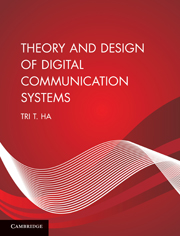Book contents
- Frontmatter
- Contents
- Preface
- Acknowledgements
- List of symbols
- List of abbreviations
- 1 Introduction
- 2 Deterministic signal analysis
- 3 Random signal analysis
- 4 Information theory and channel coding
- 5 Communication link analysis
- 6 Modulation
- 7 Demodulation
- 8 Spread spectrum
- 9 Intersymbol interference and equalization
- 10 Fading channels
- Index
- References
10 - Fading channels
Published online by Cambridge University Press: 05 June 2012
- Frontmatter
- Contents
- Preface
- Acknowledgements
- List of symbols
- List of abbreviations
- 1 Introduction
- 2 Deterministic signal analysis
- 3 Random signal analysis
- 4 Information theory and channel coding
- 5 Communication link analysis
- 6 Modulation
- 7 Demodulation
- 8 Spread spectrum
- 9 Intersymbol interference and equalization
- 10 Fading channels
- Index
- References
Summary
Introduction
Besides the intersymbol interference (ISI) that occurs via channel filtering, a digitally modulated signal can also have ISI when it is transmitted over a multipath fading channel. This type of channel is encountered in all forms of mobile wireless communication. In a multipath fading channel, the transmitted signal arrives at the receiver via multiple paths. These paths generally arise via signal reflection from the ground, hills, buildings, and any other large structures. They also arise from signal diffraction via bending around the corners of buildings or sliding across rooftops. They also can arise via signal scattering from small objects such as vehicles, lamp posts, trees, etc. Each signal path results in a randomly delayed, attenuated, and phase-shifted copy of the transmitted signal. These multipath copies combine at the receiver to give rise to a received signal whose envelope may be described by a Rayleigh fading process (no line-of-sight path), or a Rice fading process (one line-of-sight path), or a Nakagami fading process. Also, because the arrival times of the multipath copies are random, especially in a mobile environment, the multipath copies might overlap the next bit or symbol and hence cause intersymbol interference. This type of ISI cannot be eliminated by pulse shaping dictated by the Nyquist criterion for zero ISI, but can be alleviated by equalization (as discussed in Chapter 9). The above effects are collectively called fading. A fading channel that exhibits ISI is called a frequency-selective fading channel.
- Type
- Chapter
- Information
- Theory and Design of Digital Communication Systems , pp. 522 - 628Publisher: Cambridge University PressPrint publication year: 2010



